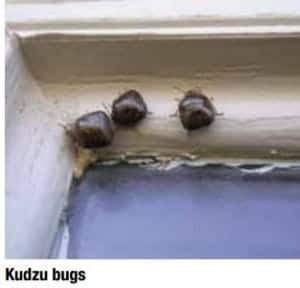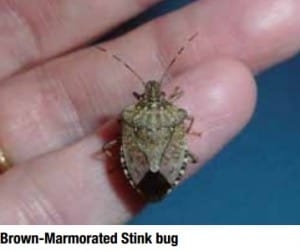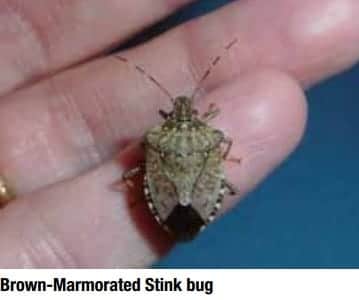There are several insect pests that try to invade homes in the fall looking for over-wintering sites. Two are relatively new introductions to Georgia.
 Kudzu bugs (Megacopta cribraria): Wider posterior than anterior, about 3/16 to 1/4 inch. Red eyes, green to brown body with stipples present on wing covers. Distinct odor.
Kudzu bugs (Megacopta cribraria): Wider posterior than anterior, about 3/16 to 1/4 inch. Red eyes, green to brown body with stipples present on wing covers. Distinct odor.
Habits: Flies to light-colored surfaces (buildings and automobiles), from nearby kudzu patches, in October/November as it looks for overwintering sites. Active again in Spring (February to April) as it awakes from Winter slumber. Native to Asia, was discovered in Georgia (and the Western Hemisphere) for the first time in October 2009. Feeds on kudzu as well as other legumes, including soybeans.
Interventions: Before kudzu bugs begin to move (October), take action to (1) seal all cracks 1/8 wide or wider, and (2) spot spray around all potential entry points with an appropriately labeled residual spray. Reapply insecticide treatments, per label specifications, through the end of November. Interventions should be implemented early enough (mid-September) so that preventative measures are in place before the onset of kudzu bug movement. In Summer, remove kudzu if possible. It is especially important to make sure all windows are screened, that doors remain closed, and doorsweeps are installed on all exterior doors. As temperatures decline into the Winter months kudzu bugs become less of a nuisance.
For more information see University of Georgia Extension circular #991, Megacopta cribraria as a Nuisance Pest.
Might Be Confused With: lady beetles, brown-marmorated stink bugs.
 Brown-Marmorated Stink bugs (Pentatomidae: Halyomorpha halys): Brown marbled- or mottled-colored stinkbug, 5/8 inch, adults with distinctive white-banded antennae.
Brown-Marmorated Stink bugs (Pentatomidae: Halyomorpha halys): Brown marbled- or mottled-colored stinkbug, 5/8 inch, adults with distinctive white-banded antennae.
Habits: First discovered in northwest Georgia in 2010, this invasive Asian species was first reported in the U.S. in Pennsylvania in 1996. An important agricultural pest of fruit crops as well as row crops and vegetables. Like the kudzu bug, boxelder bug, and multicolored Asian lady beetle, this bug is attracted to homes in the Fall in search of overwintering sites, sometimes in large numbers.
Interventions: Follow suggestions under section titled Proactive Pest Management, especially the installation of doorsweeps and screens. Before brown-marmorated stink bugs begin to seek refuge indoors (Fall), take action to (1) seal all cracks 1/8 wide or wider, and (2) spot spray around all potential entry points with an appropriately labeled residual spray. Reapply insecticide treatments, per label specifications, through the end of November. Interventions should be implemented early enough (mid-September) so that preventative measures are in place before the onset of stink bug migration indoors. It is especially important to make sure all windows are screened, that doors remain closed, and doorsweeps are installed on all exterior doors. If bugs get inside the best solution is to vacuum them. Insecticide treatments indoors are not recommended. If bugs die inside walls or in attics their carcasses can accumulate and attract other insects that eat them, especially carpet beetles.
Might Be Confused With: kudzu bugs, lady beetles.
